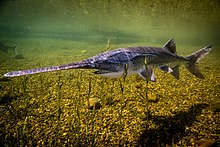| American paddlefish Temporal range:
| |
|---|---|

| |
| American paddlefish | |
| Scientific classification | |
| Domain: | Eukaryota |
| Kingdom: | Animalia |
| Phylum: | Chordata |
| Class: | Actinopterygii |
| Order: | Acipenseriformes |
| Family: | Polyodontidae |
| Genus: | Polyodon Lacépède, 1797[4] |
| Species: | P. spathula
|
| Binomial name | |
| Polyodon spathula | |

| |
| A range map of American paddlefish overlayed with a map of major rivers in the Mississippi basin | |
| Synonyms[5][6] | |
|
Genus
Species
| |
The American paddlefish (Polyodon spathula), also known as a Mississippi paddlefish, spoon-billed cat, or spoonbill, is a species of ray-finned fish. It is the last living species of paddlefish (Polyodontidae). This family is most closely related to the sturgeons; together they make up the order Acipenseriformes, which are one of the most primitive living groups of ray-finned fish. Fossil records of other paddlefish species date back 125 million years to the Early Cretaceous, with records of Polyodon extending back 65 million years to the early Paleocene. The American paddlefish is a smooth-skinned freshwater fish with an almost entirely cartilaginous skeleton and a paddle-shaped rostrum (snout), which extends nearly one-third its body length. It has been referred to as a freshwater shark because of its heterocercal tail or caudal fin resembling that of sharks, though it is not closely related.[7] The American paddlefish is a highly derived fish because it has evolved specialised adaptations such as filter feeding. Its rostrum and cranium are covered with tens of thousands of sensory receptors for locating swarms of zooplankton, its primary food source. The only other species of paddlefish that survived to modern times was the Chinese paddlefish (Psephurus gladius), last sighted in 2003 in the Yangtze River in China and considered to have gone extinct no later than 2010.
The American paddlefish is native to the Mississippi River basin and once moved freely under the relatively unaltered conditions that existed prior to the early 1900s. It commonly inhabited large, free-flowing rivers, braided channels, backwaters, and oxbow lakes throughout the Mississippi River drainage basin, and adjacent Gulf Coast drainages. Its peripheral range extended into the Great Lakes, with occurrences in Lake Huron and Lake Helen in Canada until about 1917.[8][9] American paddlefish populations have declined dramatically primarily because of overfishing, habitat destruction, and pollution. Poaching has also been a contributing factor to its decline and is liable to continue to be so as long as the demand for caviar remains strong. Naturally occurring American paddlefish populations have been extirpated from most of their peripheral range, as well as from New York, Maryland, Virginia, and Pennsylvania. They have been reintroduced in the Allegheny, Monongahela and Ohio river systems in western Pennsylvania. However, their current range has been reduced to the Mississippi and Missouri River tributaries and Mobile Bay drainage basin. American paddlefish are currently found in twenty-two states in the U.S., and are protected under state, federal and international laws.
- ^ Moore, M.; Rider, S. (2022). "Polyodon spathula". IUCN Red List of Threatened Species. 2022: e.T17938A81763841. doi:10.2305/IUCN.UK.2022-1.RLTS.T17938A81763841.en.
- ^ "Appendices | CITES". cites.org. Retrieved January 14, 2022.
- ^ Walbaum, J.J. (1792). Petri ArPetri Artedi sueci genera Piscium in quibus systema totum ichthyologiae proponitur cum classibus, ordinibus, generum characteribus, specierum diffentiis, observationibus plumiris. Redactis Speciebus 2. Ichthyologiae, III. Grypeswaldiae [Greifswald]: Ant. Ferdin. Rose. p. 522.
- ^ Lacépède, B.G.E. (1797). "Mémoire sur le polyodon feuille". Bulletin des Sciences, par la Société Philomathique de Paris. 1 (6): 49.
- ^ Froese, R.; Pauly, D. (2017). "Polydontidae". FishBase version (02/2017). Archived from the original on August 24, 2017. Retrieved May 18, 2017.
- ^ "Polydontidae" (PDF). Deeplyfish- fishes of the world. Archived (PDF) from the original on August 24, 2017. Retrieved May 18, 2017.
- ^ "Extinct freshwater sharks that spawned in saltwater had been mistaken for separate species". Scientific American. January 16, 2014. Retrieved May 5, 2019.
- ^ "COSEWIC assessment and update status report on the paddlefish Polyodon spathula in Canada" (PDF). Committee on the Status of Endangered Wildlife in Canada. April 2008.
- ^ "Aquatic Species at Rick – The Paddlefish". Fisheries and Oceans Canada. June 28, 2010. Archived from the original on August 7, 2014. Retrieved December 10, 2014.
